

 the Mesoamerica Portal
the Mesoamerica Portal _trim.png.webp)
_trim.png.webp)
_trim.png.webp)
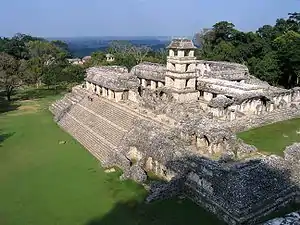
Mesoamerica (Spanish: Mesoamérica) is a region and cultural area in the Americas, extending approximately from central Mexico to Belize, Guatemala, El Salvador, Honduras, Nicaragua, and Costa Rica, within which a number of pre-Columbian societies flourished before the Spanish colonization of the Americas in the 15th and 16th centuries.
As a cultural area, Mesoamerica is defined by a mosaic of cultural traits developed and shared by its indigenous cultures. Beginning as early as 7000 BC the domestication of maize, beans, squash and chili, as well as the turkey and dog, caused a transition from paleo-Indian hunter-gatherer tribal grouping to the organization of sedentary agricultural villages. In the subsequent formative period, agriculture and cultural traits such as a complex mythological and religious tradition, a vigesimal numeric system, and a complex calendric system, a tradition of ball playing, and a distinct architectural style, were diffused through the area. Also in this period villages began to become socially stratified and develop into chiefdoms with the development of large ceremonial centers, interconnected by a network of trade routes for the exchange of luxury goods such as obsidian, jade, cacao, cinnabar, Spondylus shells, hematite, and ceramics. While Mesoamerican civilization did know of the wheel and basic metallurgy, neither of these technologies became culturally important.
Among the earliest complex civilizations was the Olmec culture which inhabited the Gulf coast of Mexico. In the Preclassic period, complex urban polities began to develop among the Maya and the Zapotecs. During this period the first true Mesoamerican writing systems were developed in the Epi-Olmec and the Zapotec cultures, and the Mesoamerican writing tradition reached its height in the Classic Maya Hieroglyphic script. Mesoamerica is one of only five regions of the world where writing was independently developed. In Central Mexico, the height of the Classic period saw the ascendancy of the city of Teotihuacan, which formed a military and commercial empire whose political influence stretched south into the Maya area and northward. During the Epi-Classic period the Nahua peoples began moving south into Mesoamerica from the North. During the early post-Classic period Central Mexico was dominated by the Toltec culture, Oaxaca by the Mixtec, and the lowland Maya area had important centers at Chichén Itzá and Mayapán. Towards the end of the post-Classic period the Aztecs of Central Mexico built a tributary empire covering most of central Mesoamerica.
Selected article
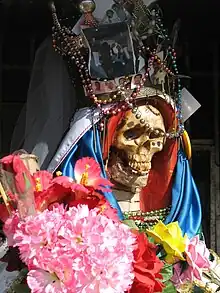
Santa Muerte (Spanish for Saint Death), is a female folk saint venerated primarily in Mexico and the United States. A personification of death, she is associated with healing, protection, and safe delivery to the afterlife by her devotees. Not sanctioned by the Roman Catholic Church, her cult arose from popular Mexican folk belief, a syncretism between indigenous Mesoamerican and Spanish Catholic beliefs and practices. Since the pre-Columbian era Mexican culture has maintained a certain reverence towards death, which can be seen in the widespread commemoration of the syncretic Day of the Dead. Elements of that celebration include the use of skeletons to remind people of their mortality. The worship is condemned by the Catholic Church in Mexico as invalid, but it is firmly entrenched among Mexico's lower working classes and various elements of society deemed as "outcasts".
Santa Muerte generally appears as a female skeletal figure, clad in a long robe and holding one or more objects, usually a scythe and a globe. Her robe can be of any color, as more specific images of the figure vary widely from devotee to devotee and according to the rite being performed or the petition being made. As the worship of Santa Muerte was clandestine until the 20th century, most prayers and other rites have been traditionally performed privately in the home. However, for the past ten years or so, worship has become more public, especially in Mexico City after Enriqueta Romero initiated her famous Mexico City shrine in 2001. The number of believers in Santa Muerte has grown over the past ten to twenty years, to several million followers in Mexico, the United States, and parts of Central America. Santa Muerte has similar male counterparts in the Americas, such as the skeletal folk saints San La Muerte of Argentina and Rey Pascual of Guatemala.
Selected biography
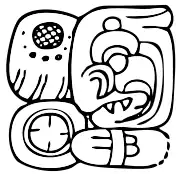
Ha' K'in Xook (Mayan pronunciation: [haʔ k’in ʃoːk]), also known as Ruler 6, was an ajaw of Piedras Negras, an ancient Maya settlement in Guatemala. He ruled during the Late Classic Period, from 767–780 AD. Ha' K'in Xook was a son of Itzam K'an Ahk II, and he ascended the throne upon the death of his brother, Yo'nal Ahk III. Ha' K'in Xook's reign seems to have ended either with his death or his abdication in favor of his brother K'inich Yat Ahk II, but archaeologists and Mayanists have not come to a clear consensus on this. Ha' K'in Xook left behind several monuments, including stelae at Piedras Negras and a stone fragment from El Porvenir. In addition, a stone seat known as Throne 1 which was erected by K'inich Yat Ahk II, records either the death or abdication of Ha' K'in Xook.
Did you know?
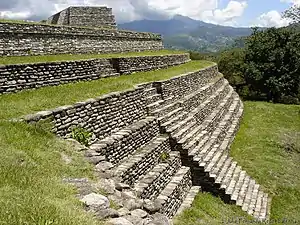
- ... that the ruins of the Maya city of Mixco Viejo (pictured) in Guatemala received their name because they were believed to be the remains of another city entirely?
- ... that Mexican feather work was prized by both Aztec and European rulers?
Subcategories
Related portals
Selected image
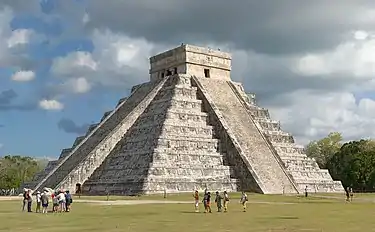 |
El Castillo, found in the Chichen Itza archaeological site, is a Mesoamerican step-pyramid that is one of the most recognized and widely visited pre-Columbian structures in Mexico. Built by the Maya, it served as a temple to Kukulkan, the Yucatec Maya Feathered Serpent deity.
Featured articles
Good Topics
 Spanish conquest of the Maya
Spanish conquest of the Maya
Good articles
 Gómez de Alvarado
Gómez de Alvarado Aztecs
Aztecs La Blanca, Peten
La Blanca, Peten Calakmul
Calakmul Bartolomé de las Casas
Bartolomé de las Casas Copán
Copán El Chal
El Chal Haʼ Kʼin Xook
Haʼ Kʼin Xook Itzam Kʼan Ahk II
Itzam Kʼan Ahk II Iximche
Iximche Kʼinich Yat Ahk II
Kʼinich Yat Ahk II Kʼinich Yoʼnal Ahk I
Kʼinich Yoʼnal Ahk I Macuahuitl
Macuahuitl Manche Chʼol
Manche Chʼol Mixco Viejo
Mixco Viejo Monarchies in the Americas
Monarchies in the Americas Motul de San José
Motul de San José Mundo Perdido, Tikal
Mundo Perdido, Tikal North Acropolis, Tikal
North Acropolis, Tikal Potbelly sculpture
Potbelly sculpture William H. Prescott
William H. Prescott Qʼumarkaj
Qʼumarkaj Resplendent quetzal
Resplendent quetzal Seibal
Seibal Spanish conquest of Yucatán
Spanish conquest of Yucatán Spanish conquest of Chiapas
Spanish conquest of Chiapas Spanish conquest of El Salvador
Spanish conquest of El Salvador Spanish conquest of Honduras
Spanish conquest of Honduras Spanish conquest of the Maya
Spanish conquest of the Maya Tikal
Tikal Toniná
Toniná Western Mexico shaft tomb tradition
Western Mexico shaft tomb tradition Benjamin Lee Whorf
Benjamin Lee Whorf Yoʼnal Ahk III
Yoʼnal Ahk III Zaculeu
Zaculeu
Topics
WikiProjects

- History
- Mesoamerica
- Aztec task force
- Archaeology
- Mesoamerica
- Mexico
- Central America
- Belize
- El Salvador
- Guatemala
- Honduras
- Indigenous peoples of the Americas
Things to do
 |
Here are some tasks awaiting attention:
|
New articles
Rules | Match log | Results page (for watching) | Last updated: 2023-11-28 22:21 (UTC)
Note: The list display can now be customized by each user. See List display personalization for details.
- Temple of the Cross (edit | talk | history | links | watch | logs | tools) by TheLonelyPather (talk · contribs · new pages (8)) started on 2023-11-28, score: 60
- Fabio Martínez Castilla (edit | talk | history | links | watch | logs | tools) by Thriley (talk · contribs · new pages (53)) started on 2023-11-27, score: 44
- İlqar Muxtarov (edit | talk | history | links | watch | logs | tools) by 180app (talk · contribs · new pages (86)) started on 2023-11-26, score: 24
- 2024 in Central America (edit | talk | history | links | watch | logs | tools) by Rickyurs (talk · contribs · new pages (72)) started on 2023-11-19, score: 46
- Slavery in Belize (edit | talk | history | links | watch | logs | tools) by Scarykitty (talk · contribs · new pages (2)) started on 2023-11-17, score: 26
- Second Central American Civil War (edit | talk | history | links | watch | logs | tools) by Emilioveh (talk · contribs · new pages (4)) started on 2023-11-15, score: 32
- Salvadoran Campaign of 1832 (edit | talk | history | links | watch | logs | tools) by Emilioveh (talk · contribs · new pages (4)) started on 2023-11-15, score: 32
- Gender relations in Guatemala (edit | talk | history | links | watch | logs | tools) by Patriciatrinidad19 (talk · contribs · new pages (1)) started on 2023-11-14, score: 36
Associated Wikimedia
The following Wikimedia Foundation sister projects provide more on this subject:
-
 Commons
Commons
Free media repository -
 Wikibooks
Wikibooks
Free textbooks and manuals -
 Wikidata
Wikidata
Free knowledge base -
 Wikinews
Wikinews
Free-content news -
 Wikiquote
Wikiquote
Collection of quotations -
 Wikisource
Wikisource
Free-content library -
 Wikiversity
Wikiversity
Free learning tools -
 Wiktionary
Wiktionary
Dictionary and thesaurus
-
 List of all portalsList of all portals
List of all portalsList of all portals -
 The arts portal
The arts portal -
 Biography portal
Biography portal -
 Current events portal
Current events portal -
 Geography portal
Geography portal -
 History portal
History portal -
 Mathematics portal
Mathematics portal -
 Science portal
Science portal -
 Society portal
Society portal -
 Technology portal
Technology portal -
 Random portalRandom portal
Random portalRandom portal -
 WikiProject PortalsWikiProject Portals
WikiProject PortalsWikiProject Portals